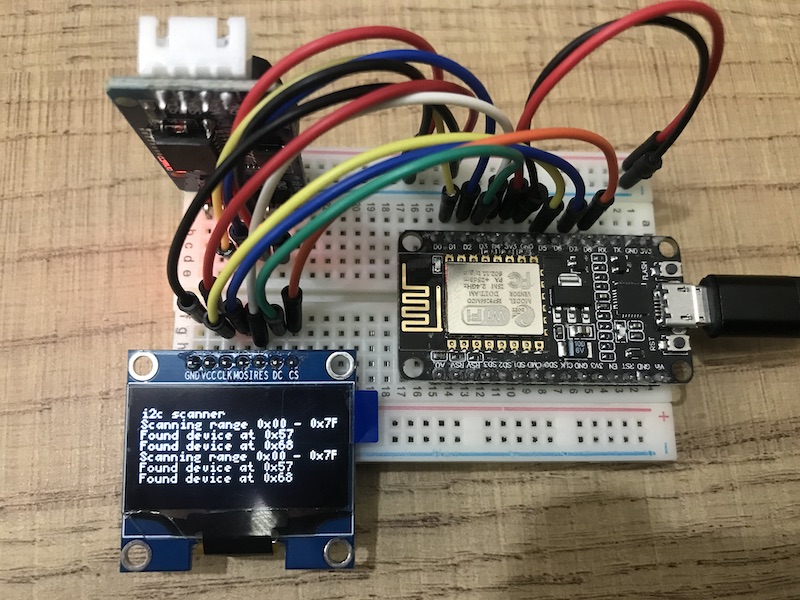I2C scanner with SH1106 OLED display output
That’s how the setup looks like:

And that’s the serial output:

Finally the code:
// I2C scanner on ESP8266 with 128x64 OLED SPI display
// Buffer 26x9 with 5x7 font
// 2020/07/14 v0.3
//
// D1 SCL GPIO5
// D2 SDA GPIO4
// D3 DC data/clock GPIO0 x
// D4 RST reset GPIO2 x
// D5 CLK clock GPIO14 x
// D6 MISO GPIO12
// D7 MOSI GPIO13 x
// D8 CS Chip Select GPIO15 x
#include <Arduino.h>
#include <U8x8lib.h>
#include <U8g2lib.h>
#include <SPI.h>
#include <Wire.h>
#include <DS3231.h>
U8G2_SH1106_128X64_NONAME_1_4W_HW_SPI u8g2(U8G2_R0, /* cs=*/ D8, /* dc=*/ D3, /* reset=*/ D4);
#define U8LOG_WIDTH 26
#define U8LOG_HEIGHT 9
uint8_t u8log_buffer[U8LOG_WIDTH*U8LOG_HEIGHT];
U8G2LOG u8g2log;
void setup(void) {
Wire.begin();
Serial.begin(115200);
Serial.println("\ni2cdetect");
u8g2.begin();
u8g2.setFont(u8g2_font_5x7_mf);
u8g2log.begin(u8g2, U8LOG_WIDTH, U8LOG_HEIGHT, u8log_buffer);
u8g2log.setRedrawMode(0); // 0: Update screen with newline, 1: Update screen for every char
u8g2log.print("\ni2c scanner\n");
}
void loop(void) {
byte error, address, address_l, address_h;
int nDevices;
Serial.println("Scanning address range 0x00-0x7F");
Serial.println(" ");
Serial.println(" 0 1 2 3 4 5 6 7 8 9 a b c d e f");
u8g2log.print("Scanning range 0x00 - 0x7F\n");
nDevices = 0;
for(address_h = 0; address_h <= 7; address_h++ ) {
Serial.print(address_h);
Serial.print("0: ");
for(address_l = 0; address_l < 16; address_l++) {
address = address_h * 16 + address_l;
Wire.beginTransmission(address);
error = Wire.endTransmission();
if (error == 0) {
Serial.print(address_h);
Serial.print(address_l,HEX);
Serial.print(" ");
u8g2log.print("Found device at 0x");
u8g2log.print(address,HEX);
u8g2log.print("\n");
nDevices++;
}
else if (error==4) {
Serial.print("xx ");
} else {
Serial.print("-- ");
}
}
Serial.println(" ");
}
if (nDevices == 0) {
Serial.println("No I2C devices found.\n");
u8g2log.print("No I2C devices found.\n");
}
Serial.println(" ");
delay(10000);
}